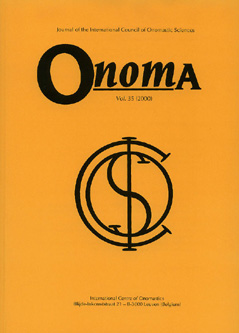 previous article in this issue previous article in this issue | next article in this issue  |

|
Document Details : Title: Alles PICCO BELLI oder was? Subtitle: Form und Funktion pseudo-italienischer Produktnamen im deutschen Lebensmittelmarkt Author(s): RIEGER, Marie A. Journal: Onoma Volume: 43 Date: 2008 Pages: 149-175 DOI: 10.2143/ONO.43.0.2062452 Abstract : Die italienische Küche erfreut sich großer Beliebtheit und steht bei Verbraucherinnen und Verbrauchern für Qualität und guten Geschmack. Dieses Herausstellungsmerkmal machen sich auch deutsche Hersteller und Handelsunternehmen zunutze, indem sie – so die Forschungshypothese – den von ihnen in diesem Produktsegment auf den Markt gebrachten Produkten ein italienisches Image verleihen. Besonders auffällig sind die Italianisierungsstrategien im Bereich der Produktnamen, die auch im Zentrum des vorliegenden Beitrags stehen. Hier kann durch eine linguistische Analyse insbesondere gezeigt werden, dass ihnen sehr ähnliche Bildungsmuster zugrunde liegen. Im Bereich von Logo und Verpackung finden sich sogar noch größere Übereinstimmungen. Im vorliegenden Zusammenhang ist die fehlende Unterscheidungskraft allerdings durchaus funktionell, denn nur durch den Rückgriff auf stereotype Vorstellungen über Italien und die italienische Sprache kann sichergestellt werden, dass die Produkte letztendlich als italienisch wahrgenommen werden. Italian food has become very popular recently, and consumers are linking it with quality and good taste. It is understandable therefore that German manufacturers and retailers are trying to make the most of this 'added value' given to products which are related to Italian cuisine. Although these products are of German production or produced for the German market, they are marketed with a characteristically Italian image. These 'Italianising' strategies using special brand names are the focus of my contribution. By a linguistic analysis, it will be shown that very similar archetypes are used for the creation of these pseudo-Italian brand names. It will also be shown that the design of logos and packaging is even less original. In this context however, the similarity which is usually considered unacceptable in the field of marketing, is functional insofar as it builds on stereotyped ideas about Italy and the Italian language. Thus, the products can be perceived as being Italian. La cuisine italienne est réputée pour sa qualité et ses saveurs. Les fabricants et entreprises commerciales allemands tirent profit de ce signe distinctif en conférant à leurs produits – telle est l’hypothèse de recherche – une image italienne. Les stratégies italianisantes sont particulièrement frappantes dans le domaine des noms de produits, qui sont au centre de l’article ci-dessous. A l’aide d’une analyse linguistique, nous démontrerons qu’ils sont formés selon des schémas similaires. Dans le domaine des logos et des emballages, ces similitudes sont encore plus grandes. Cependant, dans le cas présent, le manque de distinction remplit une fonction, dans la mesure où seul le recours à des représentations stéréotypes de l’Italie et de la langue italienne permet de garantir que les produits soient perçus comme italiens. |
|
